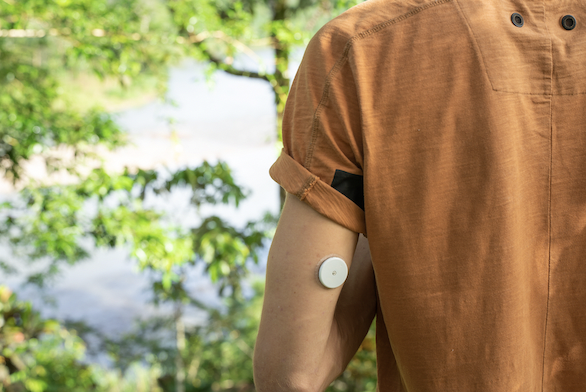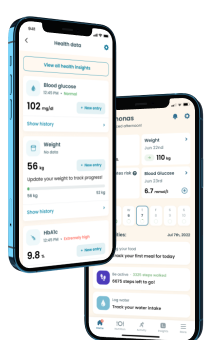What’s the difference between Type 1 and Type 2 diabetes?

Do you know what the difference between Type 1 and Type 2 diabetes is? When you hear about diabetes, you may have some vague idea that it is a severe disease but can be managed with lifestyle changes, diet modifications, and medicines.
Both types of diabetes have the same diagnostic tests and symptoms. However, their causes and treatments are very different. Let’s see what the differences are.
What is type 1 diabetes?
To understand the difference between Type 1 and Type 2 diabetes, you should know what these variants are.
Type 1 diabetes is an auto-immune disease. At one time, it was commonly called juvenile diabetes because it affects youngsters more frequently than adults. It is also called insulin-dependent diabetes.
That is because the immune system in the body destroys the cells in the pancreas responsible for insulin production. Usually, there is no insulin in the body that can be used for this reason.
The reasons that this variant develops are not very clear. It may occur due to genetic reasons or even an attack by viruses, as some people develop type 1 diabetes after an illness. Some babies may even be born with this disease.
Typically, it can be found in children between the ages of 4 and 14, though it can occur at any age. Often, it happens without warning and quite suddenly.
The symptoms
Among the symptoms of type 1 diabetes are:
- Extreme thirst and hunger
- Frequent urination
- Weight loss
- Digestive problems and nausea and vomiting
- Fatigue
- Blurred vision
- Repeated infections in the skin or genitals
- Mood swings
- Bed wetting in older children or smaller kids who have been dry for long
- Smelly urine or breath, often a fruity smell that comes from ketones
Most symptoms occur very quickly, so when several symptoms are suddenly present, it is wiser to get checked.
The risks
Poorly controlled type 1 diabetes carries many risks, no matter the patient’s age. Diabetes can cause:
- Kidney disease
- Cardiovascular problems (heart disease and stroke)
- Dental problems with the gums getting affected
- Nervous system disorders
- Eye disease and vision disorders
- Persistent skin infections
- Foot problems like ulcers or tingling
You will need to maintain normal blood sugar levels to fight it.
Treatment options
Your body needs insulin at regular intervals. It can be done via injections given 3 times a day or more frequently as advised.
Alternatively, the insulin can be delivered with an insulin pump, which delivers calibrated doses of insulin at timed intervals. The actual pump is worn outside the body, while the needle is usually inserted in the abdomen.
Different types of insulin, such as short-acting, rapid-acting, intermediate-acting, and long-acting, may be combined. It depends on your body’s response to it. Regular blood sugar monitoring is also necessary, and you may have to take your blood sugar 4 times a day. Some pumps can do all this automatically.



At the same time, you must watch what you eat, have more fruits and vegetables and whole foods and grains instead of processed foods. It is also essential to balance your intake with adequate amounts of exercise.
What is type 2 diabetes?
When you want to know the difference between type 1 and type 2 diabetes, you should know more about the variations. This is the form of diabetes that affects 90% of all patients with diabetes.
Type 2 diabetes is caused by insulin resistance in the body. Either the pancreas does not make enough insulin, or the body cannot use the insulin it makes. Since the sugar is not used by the cells, it stays in the blood and increases sugar levels in the body. And high sugar levels, because of diabetes, can cause many health problems.
Research has not found any definitive cause for Type 2 diabetes. Risk factors include age (over 45), high blood pressure, high cholesterol levels, low diet, lack of physical activity, obesity, family history, and race. Usually, a combination of factors results in Type 2 diabetes.
Type 2 diabetes is often not diagnosed in the early stages as symptoms are easy to overlook and often creep up slowly. Some people may not even have many symptoms or put them down to other causes.
The symptoms
Among the many symptoms of Type 2 diabetes are:
- Frequent need to pee, particularly at night
- Thirst
- Hunger
- Weight loss
- Tiredness
- Tingling in hands and feet
- Dry skin
- Blurred vision
- Moodiness
- Slow healing of cuts, wounds, and sores
- More than normal infections
Unlike type 1 diabetes, where many symptoms appear quickly, undiagnosed Type 2 diabetes can be more dangerous in the long run.
The risks
When excess sugar is in the bloodstream constantly, it can damage organs and cause many health problems. Uncontrolled or poorly controlled type 2 diabetes can cause:
- Heart disease
- Kidney disease
- Foot problems
- Neuropathy
- Vision problems (including vision loss due to diabetic retinopathy)
- Urinary problems, including frequent urinary tract infections
- Gum disease and dental issues
- Sexual problems (loss of libido, erectile dysfunction, and more)
It is vital to manage the sugar levels optimally to avoid these severe health problems.
Treatment options
Type 2 diabetes affects each person differently. As there are many medications available to treat this, there is no one-size-fits-all treatment. Your doctor will have to personalize your combination of drugs. This depends on how your body reacts to the medicines and your sugar levels.
Medicines for type 2 diabetes have diverse ways of working; they include:
- Metformin – lowers blood glucose levels, improves the body’s response to insulin.
- Sulfonylureas and meglitinides – improves insulin production and stimulate pancreas.
- Thiazolidinediones – improve insulin sensitivity.
- Glucagon-like peptide-1 (GLP-1) receptor agonists – improve blood sugar levels by slowing digestion.
- Sodium-glucose cotransporter-2 (SGLT2) inhibitors – don’t allow the kidneys to reabsorb glucose into the blood and sending to the urine.
Depending on your sugar levels and how you react to the medicines, your doctor may put you on one or more drugs to manage your diabetes or offer you insulin injections. Any change in medication and dosage must be closely monitored until your sugar levels stabilize.
Type 2 diabetes is not just another disease that will yield to medicines. You have to be on top of it and balance your diet, exercise, physical activity, and medicine to achieve balance and normalize blood sugar levels. It is also crucial that you lose weight if you are overweight, reduce stress levels, and be physically active (150 minutes of exercise a week is recommended).
Key Takeaways
- Type-1 diabetes is an auto-immune disease, often affecting younger people – it can occasionally affect older people.
- Type-2 diabetes is more common, affecting 90% of patients.
- Know the symptoms and seek medical advice as soon as you feel something is not right.
- Both types of diabetes can be managed—type 1 with insulin injections and type 2 with insulin or other medicines and lifestyle interventions.
- Knowing the difference between type 1 and type 2 diabeteswill enable you to take steps to stay healthy.
Take a quiz and get your diabetes-management plan today!









